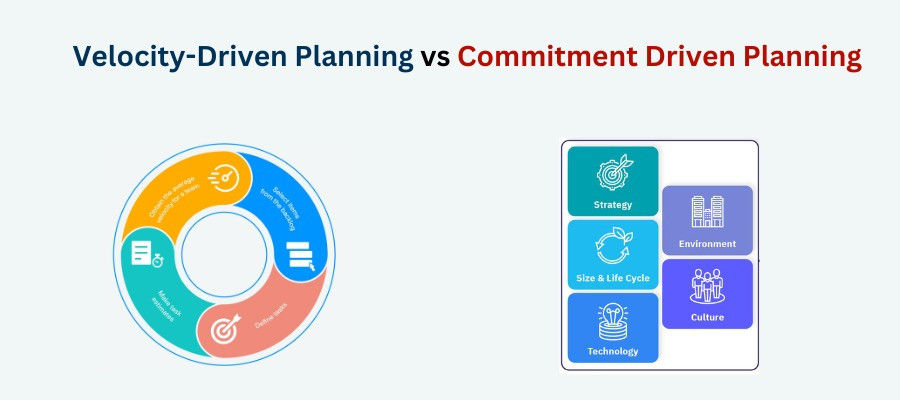Velocity Driven Planning vs Commitment Driven Planning

Projects that follow the Scrum framework utilize different Sprint Planning techniques to achieve the Product Goal at the end of every Sprint. Choosing the best-suited Sprint Planning technique isn’t just the responsibility of the Scrum Team and Scrum Master. In fact, the Product Owner and Project Manager are equally responsible to decide which Sprint Planning can be ideal for the project. Among the popular Sprint planning techniques, the velocity-driven and commitment-driven Sprint Planning techniques are widely used by the Agile Leader and Project Managers. If you are an Agile Beginner with not enough knowledge about these techniques, keep reading the guide that discusses the commonalities and differences between velocity-driven and commitment-driven Sprint Planning.
About Velocity-Driven Sprint Planning:
The Velocity-Driven Sprint Planning approach helps the Agile Team to determine the amount of work the team can complete in the current Sprint. The most important aspect of Velocity-Driven Sprint Planning is to measure and plan the Agile Team’s “Velocity”. The term “Velocity” represents the work capacity of an individual team member during an average Sprint.
Before Spring begins, the Scrum Master looks at the team's capacity to assign tasks and User Stories to the team members for the current sprint. The Developers then commit themselves to finish the assigned tasks and estimate the task complexity. Hence Velocity-Driven Sprint Planning approach helps the Scrum Team to identify how much work progress they can aim for one Sprint. The Certified Scrum Master conducts the Sprint Planning Meetings to calculate team velocity by adding individual story points of the completed User Stories. Indeed, this approach measures the output by the end of the Sprint but fails to establish the outcome.
About Commitment-Driven Sprint Planning:
Commitment-Driven Sprint Planning is often called as Capacity-Driven Sprint Planning. This technique helps the Scrum Team determine the amount of work to aim to complete in the current sprint based on the team’s capacity. Here the development & testing team has the flexibility to change individual work capacity before committing to an active User Story. Unlike Velocity-Driven Sprint Planning, this technique is not date-driven or story-driven. Instead, it focuses on the development team's planned capacity to complete the User Story or Work Item.
Velocity-driven & Commitment-driven Sprint Planning: Primary Differences
1. Steps Involved In Both Approaches:
Primary steps in velocity-driven Sprint Planning are:
- Calculate the development team’s average velocity based on the last 3 Sprints.
- Select each Product Backlog Item (PBI) based on the average velocity.
- Identify the Sprint Goal to determine individual team members’ target velocity.
- Estimate the assigned tasks and check the consistency with past sprints.
- Verify the appropriate tasks associated with the User Stories for the particular sprint.
- Split User Stories into individual tasks and assign work items to the team.
Primary steps in commitment-driven Sprint Planning are:
- Add all team members’ capacity for the sprint to determine the total team capacity.
- Discuss each Product Backlog Item with the Definition of Done to explore all scenarios.
- Negotiate with the Product Owner for Sprint Backlog Refinement.
- Add up each task’ working hours to determine the total number of hours to finish one backlog item.
- Confirm with the team if they have enough capacity to commit toward the active backlog item.
- Repeat the Sprint Planning process until the team commits to the active backlog items for the sprint.
2. Primary Characteristics of Both Approaches:
Here are the primary characteristics of velocity-driven Sprint Planning:
- Understand the Product Goal to refine Sprint Backlog and fix the amount of work committed for one sprint.
- Estimate the amount of time required to deliver the Sprint Goal by a particular date.
- Estimate a particular date to complete and deliver the committed work.
- Follow the date-driven or story-driven approach to perform Sprint Planning.
Here are the primary characteristics of commitment-driven Sprint Planning:
- Establish a balance between the Developers, Software testers, System Admins, and business stakeholders.
- Conduct long planning sessions to break down Product Backlog items accurately for the sprint.
- Achieve high levels of team autonomy by controlling their commitments towards the Sprint Goal.
- Focus on time-based estimates to determine team capacity to define the Definition of Done.
3. Pros of Both Approaches:
Pros of velocity-driven Sprint Planning are:
- Provides accurate measures of the team’s performance in the current sprint.
- Helps the Scrum Master to fix each sprint’s length based on the Sprint Goal.
- Conducts longer-term planning by considering the variable team “Velocity”.
Pros of commitment-driven Sprint Planning are:
- Consider the team’s work capacity before committing towards the Sprint Goal.
- Give the team flexibility to take up the work items for the current sprint to work on.
- Encourage team members to self-organize individual commitments for the Sprint.
4. Cons of Both Approaches:
Cons of velocity-driven Sprint Planning are:
- Team responsibility varies from one sprint to another.
- Not suitable for shorter-term Sprint Planning.
- Difficult to focus on incomplete work items from previous sprints.
- The team sticks to the velocity commitment.
Cons of commitment-driven Sprint Planning are:
- Not suitable for long-term Sprint Planning.
- The stakeholders take the commitment as a guarantee.
Conclusion:
Which one is best?
Both velocity-driven and commitment-driven Sprint Planning approaches work for Agile Project Management. But, each approach has some pros and cons. Now you have read the guide you know what are the basic differences between these approaches. Depending upon the Agile Project’s requirements, you can now choose a suitable Sprint Planning technique among these two. Always consider the best outcomes that the Sprint Planning technique can offer before selecting the right one!
Reference
- https://www.linkedin.com/pulse/velocity-driven-planning-vs-commitment-jayaram-hegde



